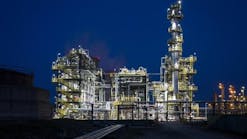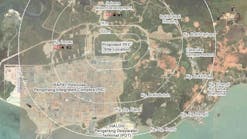HPCL Rajasthan proceeding with proposed Barmer refining complex
HPCL Rajasthan Refinery Ltd. (HRRL), a 74-26% joint venture of Hindustan Petroleum Corp. Ltd. (HPCL) and the state government of Rajasthan, is proceeding with its previously announced plan to develop the JV’s proposed 181,000-b/d integrated refinery and petrochemical complex now under construction at Pachpadra Tehsil, Barmer District, Rajasthan (OGJ Online, Jan. 10, 2018).
HPCL informed the government of India that there are no roadblocks in setting up the refinery-cum-petrochemical complex at an approved cost of 431.29 billion rupees, India's Minister of Petroleum and Natural Gas Shri Dharmendra Pradhan said in a release.
Most recently, the JV let a contract to Chevron Lummus Global LLC (CLG)—a partnership of Chevron USA Inc. and McDermott International Inc.—to deliver licensing and extended basic engineering design of a 48,200-b/d delayed coking plant at the complex based on CLG’s proprietary delayed coking technology (OGJ Online, May 10, 2019).
HRRL also awarded an earlier contract to McDermott for license and basic engineering design of two 420,000-tonne/year polypropylene units that will use Lummus’ proprietary Novolen process reactors and proprietary NHP catalyst to produce a full range of polypropylene products at the new refinery (OGJ Online, Jan. 3, 2019).
Integrated project overview
Once completed, the refinery—which will take about 4 years to build—will be equipped to produce Bharat Stage 6-grade fuels (equivalent to Euro 6-quality) from a feedstock of both locally produced and Saudi Arabian crudes to meet increased demand for petroleum products in Rajasthan as well as other northern Indian states.
During its first 8 years of operation, the refinery will be designed to process 1.5 million tpy of Rajasthan crude from nearby Mangla fields and 7.5 million tpy of imported Arab Mix crude—consisting of Arab Light and Arab Heavy grades—before switching to a full 9 million-tpy feedstock slate of Arab Mix beginning in its ninth year of operation, according to documents filed with India’s Ministry of Environment, Forest, and Climate Change (MOEFCC).
According to Engineers India Ltd.’s revised environmental impact assessment for the Barmer project filed with MOEFCC in July 2017, the complex will include the following nameplate processing capacities:
• Crude distillation, 181,000 b/d.
• Vacuum distillation, 96,400 b/d.
• Naphtha hydrotreating, 36,100 b/d.
• Isomerization, 5,200 b/d.
• Continuous catalyst regeneration reforming, 6,000 b/d.
• Diesel hydrotreating, 82,300 b/d.
• Fluid catalytic cracking, 58,200 b/d.
• Delayed coking, 48,200 b/d.
• Polypropylene (two units), 490,000 tpy each
• Butene-1, 59,000 tpy.
• Linear low-density/high-density polyethylene (two swing units), 416,000 tpy each.
• Vacuum gas oil hydrotreating, 70,300 tpy.
• Dual-feed steam cracking, 820,000 tpy.
• Low-pressure ethylene recovery, 77,000 tpy.
• Benzene recovery, 96,000 tpy.
• Pyrolysis gasoline hydrotreating, 11,000 b/d.
• BTX fractionation, 11,000 b/d.
• FCC gasoline depantanizing, 17,500 b/d.
• Gasoline hydrotreating, 10,600 b/d.
• FCC C5 Merox, 4,400 b/d.
• Saturated LPG Merox, 3,300 b/d.
• LPG depropanizing, 3,300 b/d.
• Fuel gas treating, 1,425 tonnes/day.
• Hydrogen generation, 37,000 tpy
• Pressure-swing adsorption, 28,000 tpy.
• Sour-water stripping (hydroprocessing), 100 cu m/hr.
• Sour-water stripping (nonhydroprocessing), 250 cu m/hr.
• Amine regeneration (three units), 480 cu m/hr each.
• Sulfur recovery with tail-gas treatment (two units), 199 tonnes/day each.
Contact Robert Brelsford at [email protected].

Robert Brelsford | Downstream Editor
Robert Brelsford joined Oil & Gas Journal in October 2013 as downstream technology editor after 8 years as a crude oil price and news reporter on spot crude transactions at the US Gulf Coast, West Coast, Canadian, and Latin American markets. He holds a BA (2000) in English from Rice University and an MS (2003) in education and social policy from Northwestern University.


